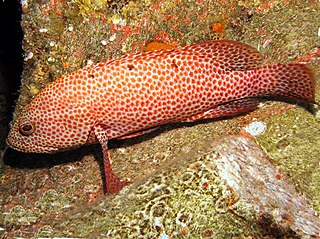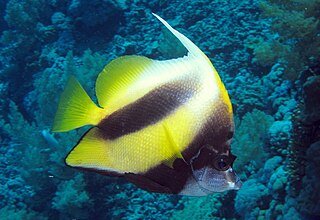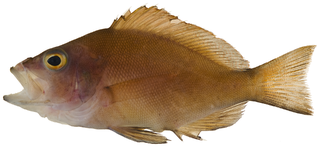
Hypoplectrus is a genus of fishes commonly known as hamlets, found mainly in coral reefs in the Caribbean Sea and the Gulf of Mexico, particularly around Florida and the Bahamas. They are a popular choice for hobbyist saltwater aquariums, and come in a variety of colors.

Mycteroperca bonaci, the black grouper, black rockfish or marbled rockfish, is a species of marine ray-finned fish, a grouper from the subfamily Epinephelinae which is part of the family Serranidae, which also includes the anthias and sea basses. Other fish are sometimes called the black grouper including the similar gag grouper, the misty grouper, and the critically endangered Warsaw grouper. This species is found in the western Atlantic Ocean from the northeastern United States to Brazil.

The graysby is a species of marine ray-finned fish, a grouper from the subfamily Epinephelinae which is in the family Serranidae which also includes the anthias and sea basses. It is found in the western Atlantic. It is associated with reefs and is a quarry species for commercial and recreational fisheries.

The belted sandfish, also known as the dwarf sea bass or stubby sea bass, is a species of marine ray-finned fish, a sea bass from the subfamily Serraninae, classified as part of the family Serranidae which includes the groupers and anthias. It is found in the western Atlantic Ocean. This species is found in the aquarium trade.

Mycteroperca microlepis, the gag, gag grouper, velvet rockfish or charcoal belly, is a species of marine ray-finned fish, a grouper from the subfamily Epinephelinae which is part of the family Serranidae, which also includes the anthias and sea basses. It comes from warmer parts of the West Atlantic, including the Caribbean and Gulf of Mexico. It is a drab, mottled-gray fish lacking the distinguishing features of most other groupers. Its pattern of markings resemble the box-shaped spots of the black grouper. It lacks the streamer-points on the tail fin that scamp and yellowmouth grouper have, and lacks yellow coloration around the mouth.

Hypoplectrus gemma, the blue hamlet, is a species of marine ray-finned fish, a sea bass from the subfamily Serraninae which is part of the family Serranidae, which also includes the groupers and anthias. It is found in the western Atlantic Ocean and occasionally makes its way into the aquarium trade.

The Red Sea bannerfish is a species of marine ray-finned fish, a butterflyfish from the family Chaetodontidae. It is found in the western Indian Ocean. It has been recorded as an introduced species off Florida and as a Lessepsian migrant in the eastern Mediterranean Sea off Turkey.

Stegastes variabilis is a damselfish in the family Pomacentridae, found on coral and rocky reefs in the Caribbean Sea and neighboring areas of the Atlantic Ocean and Gulf of Mexico. They are often solitary fish.

The masked hamlet is a species of marine ray-finned fish, a sea bass from the subfamily Serraninae which is part of the family Serranidae, which also includes the groupers and anthias. This species is found in the western Atlantic Ocean in the Caribbean Sea and has been recorded from the coast of Central America from Quintana Roo in Mexico to Bocas del Toro in Panama and from Jamaica to Puerto Rico, as well as in the Turks and Caicos and the Cayman Islands. Its specific name refers to Providencia Island, Colombia where the type was collected. It was also recorded from other islands in the Archipelago of San Andrés, Providencia and Santa Catalina. They are a unique species in the Hypoplectrus genus, defined by their unique color morph. Their behavior is largely similar to that of other hamlets, especially in their diet and egg-trading spawning patterns.

Cephalopholis fulva, the coney or the butterfish, is a species of marine ray-finned fish, a grouper from the subfamily Epinephelinae which is in the family Serranidae which also includes the anthias and sea basses. It is found in the western Atlantic. It is associated with reefs and is a quarry species for commercial and recreational fisheries. It can be found in the aquarium trade.

Epinephelus flavocaeruleus, commonly called blue-and-yellow grouper, is a species of marine ray-finned fish, a grouper from the subfamily Epinephelinae which is part of the family Serranidae, which also includes the anthias and sea basses. It is associated with reefs in the Indian Ocean.

Hypoplectrus nigricans, the black hamlet, is a species of marine ray-finned fish, a sea bass from the subfamily Serraninae which is part of the family Serranidae, which also includes the groupers and anthias. It is native to shallow parts of the central Western Atlantic Ocean and Caribbean Sea. It grows to about 15 cm (6 in) in total length. It is a simultaneous hermaphrodite, with a breeding strategy known as egg trading. One fish acts as a female and lays a batch of eggs which the other fertilises. The following night, the roles are reversed.

Hypoplectrus unicolor, the butter hamlet or yellowtail hamlet, is a species of marine ray-finned fish, a sea bass from the subfamily Serraninae which is part of the family Serranidae, which also includes the groupers and anthias. It occurs in the western central Atlantic Ocean and occasionally makes its way into the aquarium trade.
Hypoplectrus gummigutta, commonly called the golden hamlet, is a species of marine ray-finned fish. They are sea bass from the subfamily Serraninae and the greater family Serranidae, which also includes the groupers and anthias. The golden hamlet was first described in 1852 by zoologist Felipe Poey (1799-1891) as Plectropoma gummigutta before being given its accepted name: Hypoplectrus gummigutta. It is found in the western Atlantic Ocean and occasionally makes its way into the aquarium trade.

Hypoplectrus indigo, the indigo hamlet, is a species of marine ray-finned fish, a sea bass from the subfamily Serraninae which is part of the family Serranidae, which also includes the groupers and anthias. It is found in the central western Atlantic Ocean. It occasionally makes its way into the aquarium trade.

The shy hamlets are small Western Atlantic serranids of the genus Hypoplectrus, which belong to the subclass perciformes in the class Actinopterygii. To this date, seventeen species of the genus have been recognized, a third of which have been discovered in the past few years.

Liopropoma rubre, the peppermint bass or swissguard basslet, is a species of marine ray-finned fish, related to the groupers and classified within the subfamily Epinephelinae of the family Serranidae. It is found in the western Atlantic Ocean. This species is utilised in the aquarium trade.

Diploprion bifasciatum, the barred soapfish, also known as the doublebanded soapfish, two banded grouper, two-banded sea perch, two-banded soapfish, yellow emperor or yellow striped grouper, is a species of marine ray-finned fish, related to the groupers and included in the subfamily Epinephelinae which is part of the family Serranidae, which also includes the anthias and sea basses. It is found in the Indo-Pacific region.

The Spanish flag is a species of marine ray-finned fish, a grouper from the subfamily Epinephelinae which is part of the family Serranidae, which also includes the anthias and sea basses. It is found in the western Atlantic Ocean. It is the only species in the genus Gonioplectrus.

Conodon nobilis, the barred grunt, is a species of marine ray-finned fish, a grunt belonging to the family Haemulidae. It is found in the Western Atlantic Ocean where it is a target species for some commercial fisheries.




















